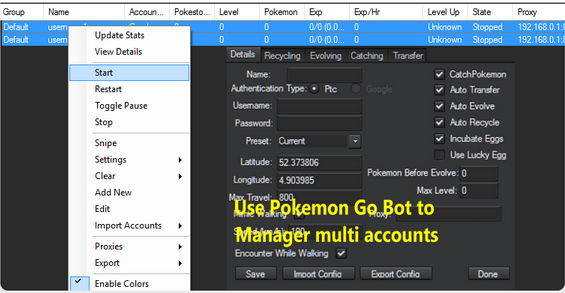- Access to unlimited network with proxy on Android phones. Proxy Manager is a simple but powerful tool to let you set proxy on phones and access network with it. And it's ad-free. Why waste time to set up proxy for apps one by one? This tool can set up global proxy for whole system once time and turn on/off it at any time. Upgrade to pro version, you can even fetch and configure proxy within 1.
- Download Best Proxy Manager for Firefox. The best anonymous proxy solution for you. Manage and switch between multiple location proxies quickly & easily.
Built as a Docker Image, Nginx Proxy Manager only requires a database. Configure other users to either view or manage their own hosts.
Nginx HTTPS Reverse Proxy Overview
A Nginx HTTPS reverse proxy is an intermediary proxy service which takes a client request, passes it on to one or more servers, and subsequently delivers the server's response back to the client. While most common applications are able to run as web server on their own, the Nginx web server is able to provide a number of advanced features such as load balancing, TLS/SSL capabilities and acceleration that most specialized applications lack. By using a Nginx reverse proxy all applications can benefit from these features.
Benefits of Using a Nginx Reverse Proxy on an Instance
There are a important benefits of setting up a Nginx HTTPS reverse proxy:
- Load Balancing: A Nginx reverse proxy can perform load balancing which helps distribute client requests evenly across backend servers. It also improves redundancy as if one server goes down, the reverse proxy will simply reroute requests to a different server according to the routing policy.
- Increased Security: A Nginx reverse proxy also acts as a line of defense for your backend servers. Configuring a reverse proxy ensures that the identity of your backend servers remains unknown.
- Better Performance: Nginx has been known to perform better in delivering static content file and analyse URLs
- Easy Logging and Auditing: Since there is only one single point of access when a Nginx reverse proxy is implemented, this makes logging and auditing much simpler.
- Encrypted Connection By encrypting the connection between the client and the Nginx reverse Proxy with TLS, users profit from a encrypted and securized HTTPS connection, protecting their data.
Requirements:
- You have an account and are logged into console.scaleway.com
- You have configured your SSH Key
- You have sudo privileges or access to the root user.
- You have an web application running on a non-standard web port on the instance
- You have a compute instance running Ubuntu Bionic Beaver
- Make sure your domain name points towards your server ip (A or AAAA record)
Installing and Configuring Nginx
Note: This tutorial requires that you have already a web application running on your instance. You can for example install a lightweight web server like Webfsd, which runs on port 8000 by default to be joignable on the standard HTTP(s) ports via the proxy. If required it can be installed with apt install webfs
In the following example, we will configure an Nginx reverse proxy in front of an Apache web server. As a result, we assume that Apache is already installed and configured (on the same machine).
1 . Update the APT packet cache and install the Nginx web server via the packet manger:

2 . Disable the default virtual host, that is pre-configured when Nginx is istalled via Ubuntu's packet manager apt:
3 . Enter the directory /etc/nginx/sites-available and create a reverse proxy configuration file.
4 . Paste the following Nginx configuration in the text editor. The proxy server redirects all incomming connections on port 80 to the Webfsd server, listening on port 8000. Edit the port value depending on the applications specific port.

Multiple Proxy Manager Software
Virtualbox additions windows 98 cd. Note: Accesses and errors are located in a log files at /var/log/nginx.
5 . Copy the configuration from /etc/nginx/sites-available to /etc/nginx/sites-enabled. It is recommended to use a symbolic link.
6 . Test the Nginx configuration file
which returns
7 . Open a web browser on your local computer and paste your public_ip which will display your web applications homepage.

Adding TLS to your Nginx Reverse Proxy using Let's Encrypt
Important: Make sure your domain name points towards your server ip (A or AAAA record).
With the current setup, all incoming traffic on the standard, non-securized, HTTP port is anserwered by Nginx, which passes it to the web application on the instance.
For security reasons, it is recommended to add an encryption layer with TLS/SSL and to use HTTPS. Whilst it is technically possible to use self-signed certficates, it may cause very inconveniences as a warning is displayed by default in an users web browser when a self-signed certificate is used. A certificate authentity (CA) can issue trusted certificates which a recognized by most modern web browsers. The CA Let's Encrypt provides TLS certificate for free and the configuration of Nginx can be done easily with Certbot, a tool provided by the EFF.
1 . Install Certbot on your instance by using the APT packet manager:
2 . Certbot provides a plugin designed for the Nginx web server, automatizing most of the configuration work related with requesting, installing and managing the TLS certificate:
3 . Answer the prompts that display on the screen to request a valid Let's Encrypt TLS certificate:
Multiple Proxy Manager Job

2 . Disable the default virtual host, that is pre-configured when Nginx is istalled via Ubuntu's packet manager apt:
3 . Enter the directory /etc/nginx/sites-available and create a reverse proxy configuration file.
4 . Paste the following Nginx configuration in the text editor. The proxy server redirects all incomming connections on port 80 to the Webfsd server, listening on port 8000. Edit the port value depending on the applications specific port.
Multiple Proxy Manager Software
Virtualbox additions windows 98 cd. Note: Accesses and errors are located in a log files at /var/log/nginx.
5 . Copy the configuration from /etc/nginx/sites-available to /etc/nginx/sites-enabled. It is recommended to use a symbolic link.
6 . Test the Nginx configuration file
which returns
7 . Open a web browser on your local computer and paste your public_ip which will display your web applications homepage.
Adding TLS to your Nginx Reverse Proxy using Let's Encrypt
Important: Make sure your domain name points towards your server ip (A or AAAA record).
With the current setup, all incoming traffic on the standard, non-securized, HTTP port is anserwered by Nginx, which passes it to the web application on the instance.
For security reasons, it is recommended to add an encryption layer with TLS/SSL and to use HTTPS. Whilst it is technically possible to use self-signed certficates, it may cause very inconveniences as a warning is displayed by default in an users web browser when a self-signed certificate is used. A certificate authentity (CA) can issue trusted certificates which a recognized by most modern web browsers. The CA Let's Encrypt provides TLS certificate for free and the configuration of Nginx can be done easily with Certbot, a tool provided by the EFF.
1 . Install Certbot on your instance by using the APT packet manager:
2 . Certbot provides a plugin designed for the Nginx web server, automatizing most of the configuration work related with requesting, installing and managing the TLS certificate:
3 . Answer the prompts that display on the screen to request a valid Let's Encrypt TLS certificate:
Multiple Proxy Manager Job
Chrome Proxy Manager
When asked if you want to redirect HTTP traffic automatically to HTTPS, choose the option 2. This enables the automatic redirection of all incoming requests via an unencrypted HTTP connection to a secure HTTPS connection. Providing an additional layer of security for the Web application running behind the Nginx reverse proxy.
